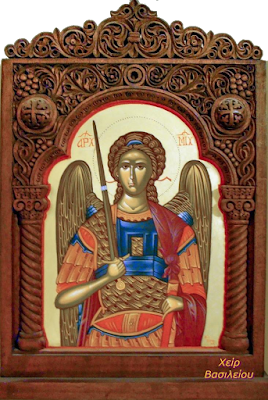•a) The art of ancient Greece
•b) The art of the East
•c) The Hellenistic art (portraits at Fagium)
•d) The Greekoroman art (wall paintings of
Pompeii)
In point of fact, the two large branches, the
eastern and the Hellenistic are the main factors that acted as
catalyst in the creation of this art. In greater detail, Great
Alexander and his successors succeeded in the creative union of the
ancient Greek art with the already existing eastern one. The fruit of
the union is the Hellenistic art. The arrival of Christianity
influenced the Hellenistic and in this way brought on the Orthodox
painting. Of course the character of the art achieved its full
potential in the Byzantium, when Constantinople became the centre of
the Byzantine Empire. There happened the selection of the artistic
elements of the two worlds (eastern and Hellenistic) and provided the
final character to the painting art.
Occasion where we can observe the influence
which was incorporated by the byzantine art, are the following.
•- In the catacombs of Rome, the fish and the vine are
eastern elements
•- Again in the catacombs the display of seasons, the
different personifications (of the sun, sea ) etc are elements of the
Hellenistic branch.
•- The Good Shepherd of Ravenna, the monastery of the
Nation in Constantinople and a great number of monuments are
characteristic examples of Hellenistic influence.
•- From ancient Greece we have the winged angels, the
face of Christ in the early Christian period as a beardless youth and
other occasions
Of course we should mention that apart from the
eastern influence much more intense was the influence of the Greek
art, of the Greek spirit. Finally we should not omit to mention in a
very significant finding in our century, the portraits in the Fagium
area. They were discovered in Egypt, west of the Nile and samples
exist in our Benakio Museum in Athens. It concerns family portraits
and are dated from the 1st to 4rd century AD. They were drawn by
Greek artists and has been proved that they formed the coupling link
between the ancient Greek art and the byzantine. All these elements
and the technical methods we mentioned, Orthodoxy took hold of them,
improved them, modified them imparting them a spiritual
characteristic so as to enable the expression of the lofty truths of
our faith.
The
art of byzantine hagiography is distinguished by:
A.
Portable Icons
These icons are usually drawn on wood and the
colours are dissolved in egg yoke. Of course, an icon can be painted
on some other surface, such as ceramic, old wood, textile, plaster
etc, save the selection of materials be such as not be disdainful to
the depicted persons. In the Christian icons we encounter the
"burning technique" which was mainly developed in the 6th
century AD. In this technique we have mixing of the colours with wax
and heating of the surface with a hot iron. When the hot iron is not
used but the coloured wax is spread on the wood we have what is
called "wax - poured icons".
The "enamel technique" was
outstanding in Byzantium. The icon was made on a metallic substrate.
With slim wires they drew the outline of the forms (faces etc) and
between the wires they poured enamel colours. To this, so called
enclosed enamels, are included icons, manuals, holy chalices, relic
holders, and other items of fine and detailed work.
B. Wall
paintings
In this wall painting category we have two
techniques. The first one is the damp drawing or "fresco".
In this technique the hagiographer draws on a freshly plastered wall.
Only as long as the plaster is still damp the work could succeed
because once the plaster is dried no correction can be made. A second
technique is the "xerography" (dry drawing). Here we have
the mixing of the colours with a sticky substance and the drawing is
on a dry wall.
C.
Mosaics
In the mosaics instead of colours, small pieces
of marble, stones, ivory, stained glass shards are used. They are
called mosaic because the walls of caves dedicated to the Muses were
decorated with mosaics. While it is not possible to achieve a soft
and gradual transition of colours that are used in painting with
mosaics, yet the brightness and liveliness of the mosaics instill in
the faithful the feeling of transcendence to a different, more
spiritual dimension. The works at Saint Luke in Lebadia, in the New
Monastery of Chios, in the Monastery of the Nation etc, are
considered classics.
D.
Micrography (Miniature drawing)
Micrography or miniature is used mainly for
decoration of the manuscripts. The detail and perfection of the
features in these works is impressive. The manuscript usually is made
of parchment and is called illustrated manuscript.
Πηγή: http://www.impantokratoros.gr/B54E886C.en.aspx










Δεν υπάρχουν σχόλια:
Δημοσίευση σχολίου
Σχόλια